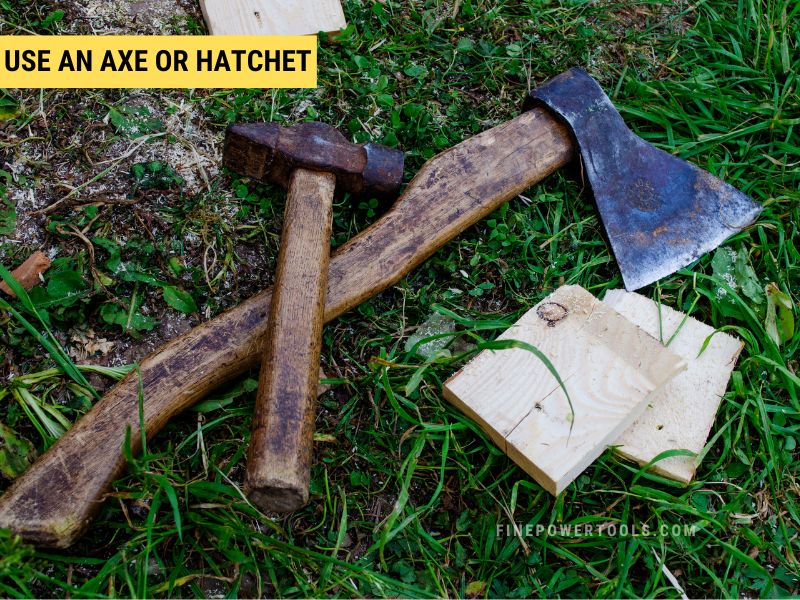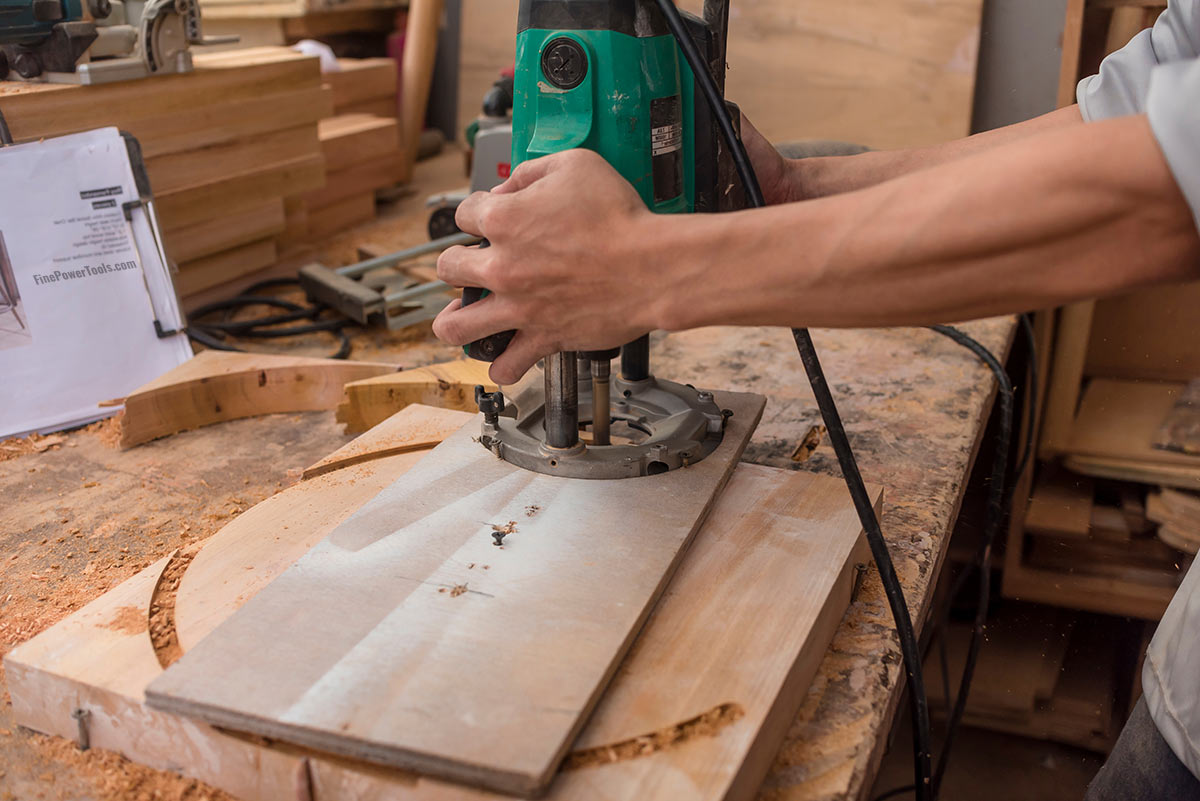While wood saws like chainsaws, circular saws, or table saws are the standard tools for cutting wood, it is not the only tool at your disposal. You can use other tools to cut wood when a saw is unavailable.
Some of these methods go back to a time in which standard tools did not exist.
In this article, I’ll explain various tools and techniques for cutting wood without a saw, shedding light on their practicality and effectiveness.
Using Hand Tools
Before electricity, hand tools were the most common method of cutting wood. And even today, they are still used in certain situations when saws are either not the right tool or available to be used.
Hatchet or Axe
For thicker pieces of wood, a hatchet or axe is the perfect choice. However, you should think of this method as splitting the wood, not making a precise cut. But with the right technique, you can make a clean break in the wood that will be along the lines of the grain.
The method you use will depend on what you are trying to achieve. If you are splitting wood, then you will need to see the grain. This will help you align the axe or hatchet properly so you can make the right cuts.
Chisel and Hammer
Chisel and hammer are generally used for wood carving, shaping, cutting slots and pockets for joinery, etc. A chisel is not designed to slice through the wood, but it can be used to cut if the wood is not too thick.
In other words, if you need to cut a thinner piece of wood, then a chisel and hammer would work. If you need to cut down a tree or saw off a branch, you must axe or a chainsaw.
How to Cut:
- Mark the line you want to cut into the wood.
- Place the chisel at the start of the line and gently tap it with the hammer.
- Increase the striking force until it begins to cut into the wood.
- Go up the line until the wood is fully cut.
The key is to make small, gradual cuts along the line with the chisel. This means starting off with light strikes and gradually increasing the force until the cut is precisely made.
Knife / Machete
A sharp knife should do the trick if a chisel and hammer are not handy. The key is making several cuts along the marked line until the wood breaks.
The upside is that you are most likely to have a good survival knife since it is an essential tool for being out in the woods.
The downside is that the knife will work only on thinner cross-sections.
You could also use a machete to cut tree branches and wood pieces. A machete can help you cut apart smaller pieces of wood to create a tinder for your fire.
While the above methods work, they take more effort and do not replace good hand saws.
But what if you do have power tools other than a power saw?
Using Power Tools
Here are the power tools and the methods you can use to cut the wood without a saw.
Wood Router
A router is designed for milling slots in wood. But you can use a plunge router instead of a sawblade to cut through wood boards.
When cutting wood with a router, avoid doing all the work at once. Instead, you’ll want to make several passes at the wood along the same line until it is properly cut.
- Mark where you want to cut the wood.
- Set a shallow depth for the router and make the first pass.
- Increase the depth and make another pass.
- Keep increasing the depth on each cut until it completely goes through the wood.
The advantage of using a router is that it is precise and creates clean edges.
The downside is that the router bit cuts into the wood at a predetermined depth, and the process is slow. The thicker the wood, the more passes you will need to make to get a precise cut.
You could also use a Dremel as a router and cut wood.
Chain Drilling
You can drill several holes along the line in which you want to cut, then use a chisel to remove the material in-between the holes. This method is simple and quite effective at getting a cut.
The upside is that you are using the drill and chisel the way they are meant to be used.
The downside is that the cut itself will not be that precise. This is a great method for making a cut, but not a precise one. You will need to shape the edges further with a chisel and sand it for cleaner lines.
Angle Grinder with Cutting Disc
Did you know that angle grinders can be used on wood?
While you cannot use the standard abrasive wheels on wood (those are for cutting metal), you can get special wood cutting discs with carbide tips for your angle grinder. I have explained the method in detail here.
Using Natural Methods
Suppose you have no tools at your disposal. If so, there are still a few ways to cut wood effectively using methods first developed during the pre-history of humanity.
Fire
Fire has been used to weaken wood so that it can be separated easily. You can use fire to weaken wood along a cut line. The upside is that when used correctly, you can weaken the wood to the point where it will break apart along the line.
However, fire is quite risky and not precise. So, you may not get the result you want. Plus, the fire presents a hazard that may present too much danger for you.
Water & Freezing
You can soak the area along the cut line with water and then freeze the entire piece of wood. Because the water will freeze as well, it makes the area along the cut line more fragile and easier to break.
While this method is much safer compared to fire, it can be quite imprecise as well.
Using Miscellaneous Tools
There are other tools and items at your disposal that can cut wood as well. While some of these tools may fall under the broad classification of saws, these are not traditional wood saws.
- Wire saw: Wire saw is quite handy for cutting branches and felling small trees. Simply hold the wire saw at both ends and pull it back and forth along the cut line.
- Cordage Saw: This is quite similar to wire as a strong piece of cord can be used to cut along a cut line and remove branches.
- Wedge & Split: A wedge and split method is commonly used to split larger logs. You will need a sledgehammer or similar tool to get it to work properly.
- Abrasion: A rough stone can be used to cut along a pre-determined line in the wood. This is more of a gouging method that works but can be quite labor-intensive.
Closing Thoughts
It’s crucial to note that, except for using a wood router, most alternative methods will typically result in rough edges. These usually necessitate additional refining steps, such as cleaning the cut surfaces and sanding, to achieve a smooth and finished look.
Whichever method you choose to cut wood without a saw, prioritizing safety is paramount to prevent any accidents or injuries.






